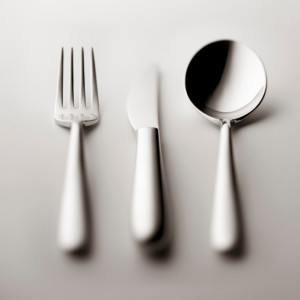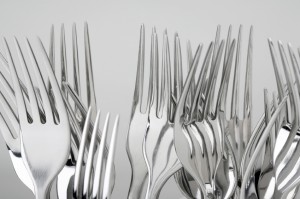 Purchasing flatware for your kitchen, be it at home or for a restaurant, is often an expensive essential when you’re looking for quality. Whether you’re buying flatware for the first time, looking to re-stock after a move, or aiming to improve the atmosphere of your eatery with new utensils, it’s wise to know a few do’s and don’ts when it comes to combating wear and tear.
Purchasing flatware for your kitchen, be it at home or for a restaurant, is often an expensive essential when you’re looking for quality. Whether you’re buying flatware for the first time, looking to re-stock after a move, or aiming to improve the atmosphere of your eatery with new utensils, it’s wise to know a few do’s and don’ts when it comes to combating wear and tear.
From picking out your pieces to running them through the wash, finding and keeping quality flatware in excellent condition is pretty simple and straightforward:
What makes quality flatware quality flatware?
Two factors that separate most forks, spoons, knives, and the likes when it comes to quality are composition and weight. The composition of your flatware’s stainless steel coupled with its weight class determines how durable each piece is and essentially how long it will last in your kitchen.
Composition – While all flatware is made of stainless steel, not all stainless steel is created equal. In fact, the “stainless” is unfortunately a misnomer, as most stainless steel does indeed rust over time, and most manufacturers add metals like chromium and nickel to help prolong the inevitable rusting. The difference in percentages of both metals is apparent in 18/0 stainless steel and 18/10 stainless steel.
- 18/0 stainless steel has 18% chromium added and 0% nickel, making it the more economical, inexpensive choice of flatware. Great for homes or restaurants where flatware is abused or goes missing often, 18/0 stainless steel utensils lack the luster of their nickel-rich counterparts and are more susceptible to rust and staining.
- 18/10 stainless steel also has the 18% chromium coating, strengthening the steel, but has an additional 10% nickel content for added brilliance and rust-resistance. 18/10 flatware sits on the more expensive end of the flatware spectrum, and the presentability of each piece makes it suitable for professional and formal occasions.
Weight – Weight classes, much like composition, ascend from the least expensive, most economical flatware to the pricier, flashier pieces. Determining which flatware will perform appropriately in your kitchen is a must.
- Medium flatware, also known as “economy weight”, has a relatively short lifespan and is easily manipulated. Being the most affordable to replace, and the easiest to get over losing, medium duty flatware is ideal for home use or casual eateries.
- Heavy flatware is one step up and is the most common flatware in use. Much sturdier than medium weight, but still bendable by hand, heavy duty utensils last longer and are a little more expensive.
- Extra Heavy flatware is yet another step up in weight class and is therefore more expensive and more durable. Extra Heavy utensils don’t break or bend as often or as easily.
- European Style flatware is most commonly used in high-end establishments due to the size and added weight. About three times heavier and bigger than traditional weight class flatware, European Style flatware is perfect for formal serving or celebration.
Caring for your flatware

Depending on the quality of your flatware, and even if it’s 18/0 medium weight, you’ll want to keep it in attractive, usable shape for as long as you can. Failing to care for your flatware is a quick road to rust-speckled spoons and flaking forks. Luckily practicing a few simple care tactics when cleaning up after a meal can drastically extend the life of your flatware.
- Pre-soak your utensils for approximately 10 minutes before running them through the dishwasher. Pre-soaking flatware helps break down the food remnants that cling to tines and nestle into crevices, and if you don’t let flatware soak before washing there’s a good chance your dishwasher could miss some spots. NOTE: Pre-soaking for longer than 10 minutes is not recommended as it encourages rust to start forming. Also, do not soak in aluminum or metal pans as the pans react with chlorine in the water and speed up the oxidation (rusting) of stainless steel.
- Remove food bits manually with a soapy sponge after a good pre-soak to ensure you get everything, but avoid using abrasive pads or steel wool. Rough pads tend to scratch and tarnish the surface of your flatware and create tiny grooves where rust likes to form.
- Run your pre-soaked utensils through a high temperature dishwasher to properly wash them, but remember to avoid using chemicals that will damage your flatware like bleach or chlorine.
- Once washed, don’t let your flatware sit before drying. Dry as soon as possible. Using a dishwasher’s drying cycle is a good start, but to be sure each piece is dried thoroughly wipe them down with a cloth or towel. Remember, the longer your flatware is wet the quicker rust will move in and take over.
- Store your flatware somewhere it will stay dry.
With so much going on in the kitchen, especially in an ever-busy eatery, it’s easy to overlook the little things. Given that your forks, spoons, and knives are used and re-used on a daily basis (if not hourly) it’s important to not let caring for your flatware become one of those little things.
 Corner Booth Blog | TundraFMP Restaurant Supply, News & Equipment Blog
Corner Booth Blog | TundraFMP Restaurant Supply, News & Equipment Blog



